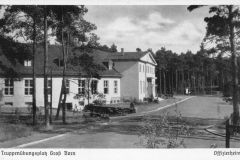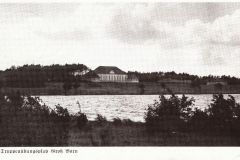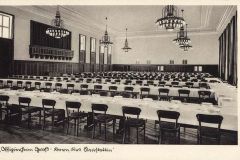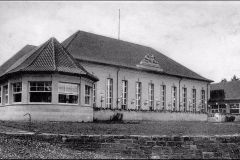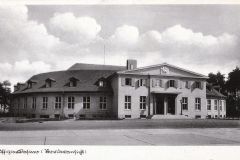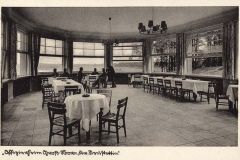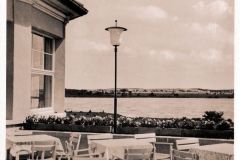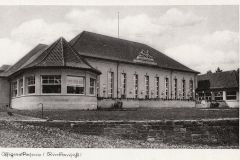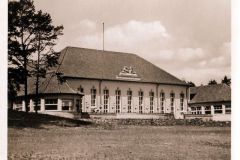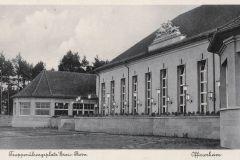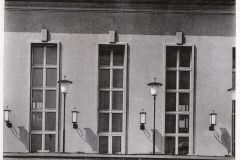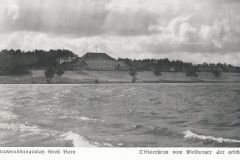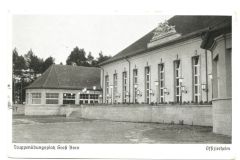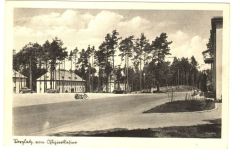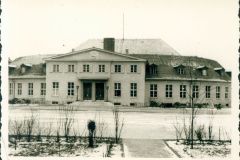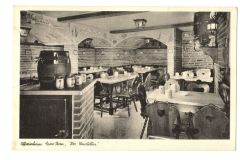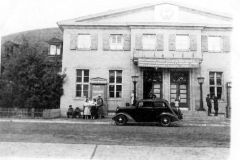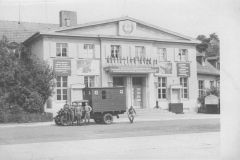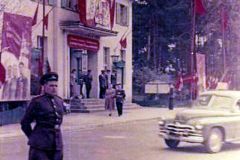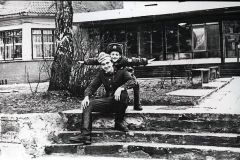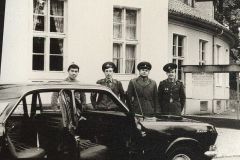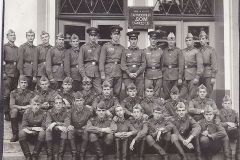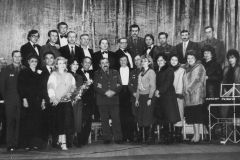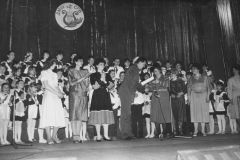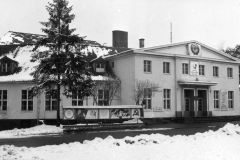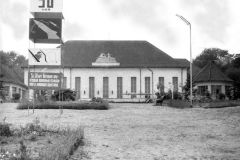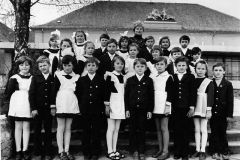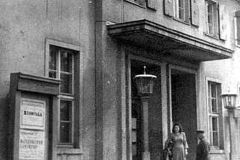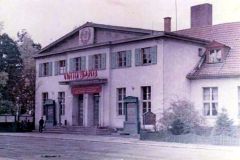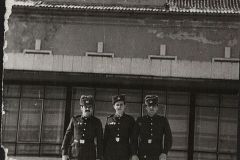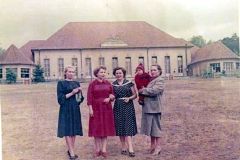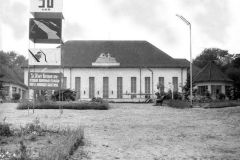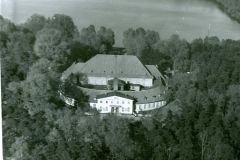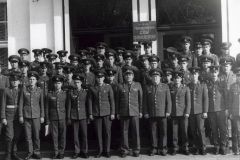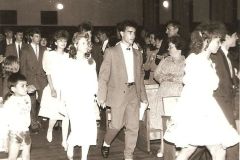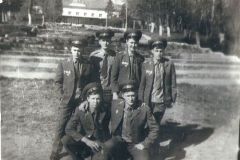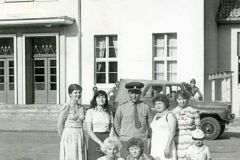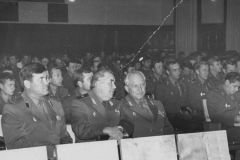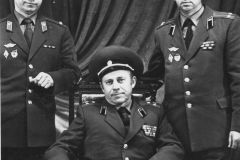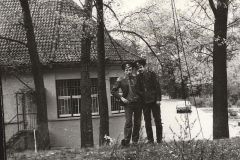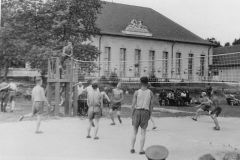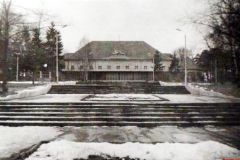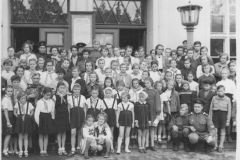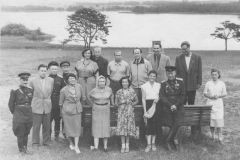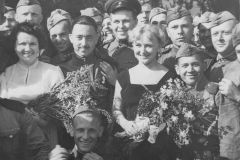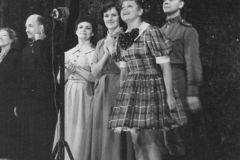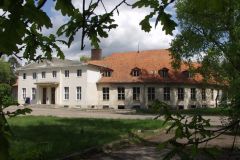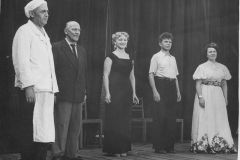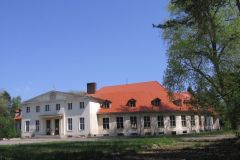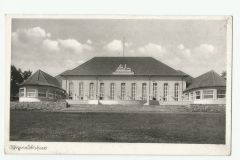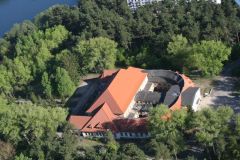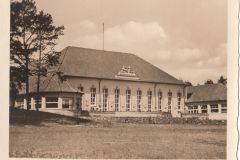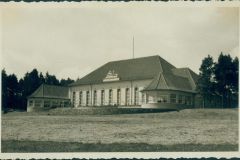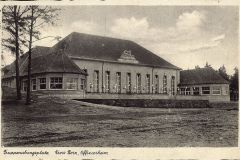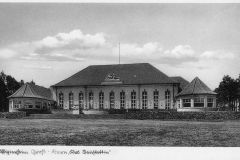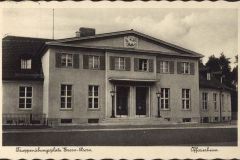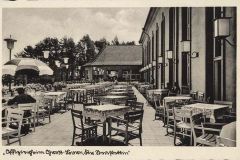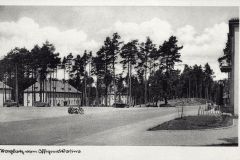![]()
KASYNO OFICERSKIE (GARNIZONOWY DOM OFICERA)
Obiekt pełniący funkcje reprezentacyjne, zbudowany przez Niemców w latach 1935 – 1936 nad jez. Pile. W latach 1936 – 1945 miejsce lokalizacji Kasyna oficerskiego i znanej restauracji dla oficerów Wehrmachtu, którą prowadził Georg Tobek. W budynku odbywały się również wykłady i szkolenia dla oficerów, głównie artylerii i wojsk pancernych (m.in. gen. Heinza Guderiana). Ciekawostką jest fakt, iż w 1942 r. ten ogromny gmach o powierzchni ok. 6.000 m2 wykorzystywało do celów szkoleniowych niemieckie lotnictwo wojskowe szkoląc tu oficerów w Luftwaffe Kampfschule Gross Born. Za czasów radzieckich w budynku mieścił się Dom Kultury dla oficerów i ich rodzin, w którym znajdowały się: sala taneczna, szkoła muzyczna, biblioteka, sala kinowa, sala balowa i restauracja. Obiekt posiadał salę koncertową dla około 1.000 osób. W sali koncertowej świętowano najważniejsze uroczystości takie jak: 1 maja, rocznicę zakończenia II wojny światowej, Rocznicę Rewolucji Październikowej, Dzień Kobiet i Nowy Rok. Podczas uroczystości w budynku odbywały się koncerty i przedstawienia wybitnych zespołów wojskowych oraz artystów z byłego ZSRR i Polski. Podczas pożaru 1 lutego 2010 r. spłonęła największa część budynku. Całkowitemu zniszczeniu uległa więźba dachowa nad pomieszczeniami sali koncertowej. Obiekt jest własnością prywatną.
![]()
OFFICERS’ MESS (GARRISON OFFICER’S CLUB)
The building situated by Lake Pile was built in between 1935-1936 by the Germans and was used for representative purposes. In between 1936-1945 the building housed the Officers’ Mess and a well-known restaurant for Wehrmacht officers run by Georg Tobek. The building was also used for lectures and professional trainings of officers, mainly artillerymen and armor troops (ex. gen. Heinz Guderian). What is interesting, in 1942 this 6,000 m2, enormous building was used by German military aviation to train officers in Luftwaffe Kampfschule Gross Born. During the Soviet period the building housed a community centre for officers and their families; it had: a dance hall, a music school, a library, a theatre, a ball room, and a restaurant. It housed a concert hall that could accommodate around 1,000 people. The concert hall was used to celebrate such important events as: May 1, the anniversary of End of World War II, the anniversary of Russian Revolution, Women’s Day, and the New Year. The celebrations included concerts and performances of illustrious military bands and artists from the former SSSR and from Poland. Most of the building went down in flames during the fire of the 1st of February 2010. The roof truss of the concert hall was completely destroyed. The building is a private property.
![]()
OFFIZIERSKASINO (OFFIZIERSHAUS DER GARNISON)
Ein großes Gebäude, das eine, vor allem repräsentative Funktion hatte. Erbaut in den Jahren 1935 bis 1936, am Ufer des Großen Pilburgsees. Von 1936 bis 1945 ein Offizierskasino und ein, von Georg Tobek geführtes Restaurant für die Offiziere der Wehrmacht. In dem Gebäude fanden die Lehrgänge und Schulungen für die Offiziere, hauptsätzlicht der Artillerie und Panzerverbände (u.a. des Generals Heinz Guderian) statt. Interessant ist auch die Tatsache, dass das Haus auch von den deutschen Luftstreitkräften genutzt wurde, in dem man hier die Offiziere in der „Luftwaffe Kampfschule Groß Born“ schulte. Während der „sowjetischen Zeit“, diente das Gebäude als Kulturhaus für die Offiziere und deren Familien. Es beherbergte einen Tanzsaal, eine Musikschule, eine Bibliothek, ein Kino, einen Ballsaal und ein Restaurant. Das Highlight war ein Konzertsaal für ca. 1000 Personen. Hier wurden die größten Feste wie der 1. Mai, der Tag des Sieges über Nazideutschland, Jahrestag der Oktoberrevolution, der Tag der Frauen und Neues Jahr gefeiert. Auf diesen Festen gab es Konzerte der besten Militärorchester und es traten die besten Artisten aus der ganzen Sowjet Union auf. Am 01. Februar 2010 zerstörte ein Brand den größten Teil des Offiziershauses. Das Dach über dem Konzertsaal wurde komplett vernichtet. Das Objekt ist Privateigentum.

